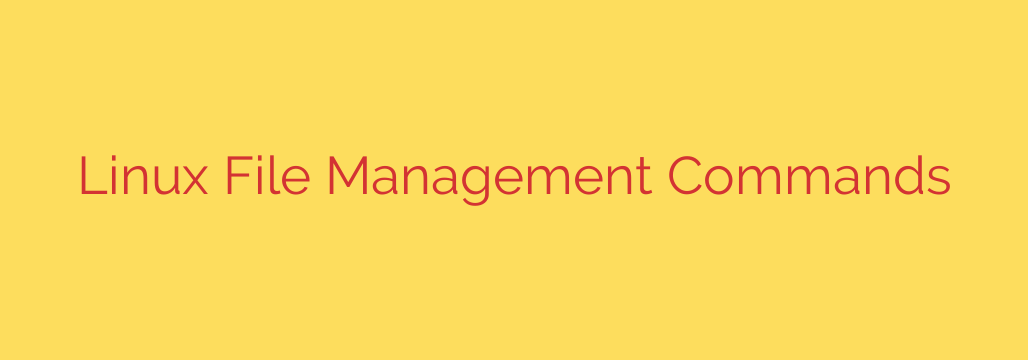
Your Ultimate Guide to Linux File Management Commands
At the heart of Linux is the command line—a powerful interface that offers unparalleled speed and control over your system. For new and experienced users alike, mastering file management commands is the first step toward true proficiency. Understanding how to navigate, create, modify, and delete files and directories directly from the terminal is an essential skill for any developer, system administrator, or power user.
This guide provides a clear and practical overview of the most critical Linux commands for managing your filesystem.
Navigating and Viewing Your Filesystem
Before you can manage files, you need to know how to move around and see what’s there. These commands are your fundamental tools for orientation.
pwd(Print Working Directory)
This is your “you are here” map marker. At any time, typingpwdwill display the full path of the directory you are currently in. It’s a simple but crucial command for getting your bearings.cd(Change Directory)
Thecdcommand is used to move between directories. You can specify a full path (e.g.,cd /var/log) or a relative path. For example,cd ..moves you up one level to the parent directory, whilecd documentsmoves you into a subdirectory named “documents.”ls(List)
To see the contents of your current directory, use thelscommand. Whilelsby itself is useful, it becomes incredibly powerful with options (flags). The most common combination isls -la, which provides a long, all-inclusive list. This shows you hidden files, permissions, ownership, file sizes, and modification dates.
Creating Files and Directories
Building out your project structure or creating new configuration files starts with these commands.
mkdir(Make Directory)
When you need to create a new folder,mkdiris the tool for the job. Simply typemkdir directory_nameto create it. For a common and useful trick, use the-pflag (mkdir -p project/assets/images) to create the entire path of nested directories at once, even if the parent directories don’t exist yet.touch(Create a File)
Thetouchcommand is the quickest way to create a new, empty file. For example,touch new_file.txtwill create that file in your current location. It can also be used to update the modification timestamp of an existing file.
Copying, Moving, and Renaming
Organizing your filesystem often involves shuffling files and directories around.
cp(Copy)
To duplicate a file, use thecpcommand with the source file and the destination path. The syntax iscp [source] [destination]. For instance,cp document.txt backups/copiesdocument.txtinto thebackupsdirectory. To copy an entire directory and its contents, you must use the recursive flag:cp -r project_folder/ project_archive/.mv(Move or Rename)
Themvcommand serves two purposes. Its primary function is to move a file or directory to a new location, like this:mv report.pdf final_reports/. Its second function is to rename a file. If the source and destination are in the same directory, it effectively renames the file:mv old_name.txt new_name.txt.
Deleting Files and Directories
Removing unnecessary files is a critical part of system maintenance. However, exercise extreme caution with these commands, as actions performed in the Linux terminal are often permanent.
rm(Remove)
Thermcommand is used to delete files. A simplerm filename.txtwill permanently delete the file. To delete a directory and all of its contents, you must use the recursive flag,rm -r.rmdir(Remove Directory)
This command is a safer way to delete directories, asrmdirwill only work on completely empty directories. If the directory contains any files or other folders, the command will fail, preventing accidental data loss.
Actionable Security Tip: The command rm -rf (recursive force) is extremely powerful and dangerous. It will delete a directory and everything inside it without any confirmation prompts. Always double-check your path and syntax before executing rm -rf, as a mistake can wipe out critical system files or personal data irreversibly.
Finding Files and Content
When you can’t remember where a file is or need to find specific text within a file, these search tools are invaluable.
find
Thefindcommand is a robust tool for searching for files and directories based on various criteria like name, size, modification time, or permissions. A common use is to find a file by its name within the current directory and all subdirectories:find . -name "*.log"will find all files ending with the.logextension.grep
Whilefindlocates files,grepsearches for specific text inside them. This is incredibly useful for parsing log files or searching for a specific function in your code. For example,grep "error" /var/log/syslogwill scan the system log and display every line containing the word “error.”
By mastering these essential commands, you gain precise and efficient control over your Linux environment. Practice is key, so open a terminal and begin building the muscle memory that will make you a more effective and confident Linux user.
Source: https://linuxhandbook.com/file-management-commands/








